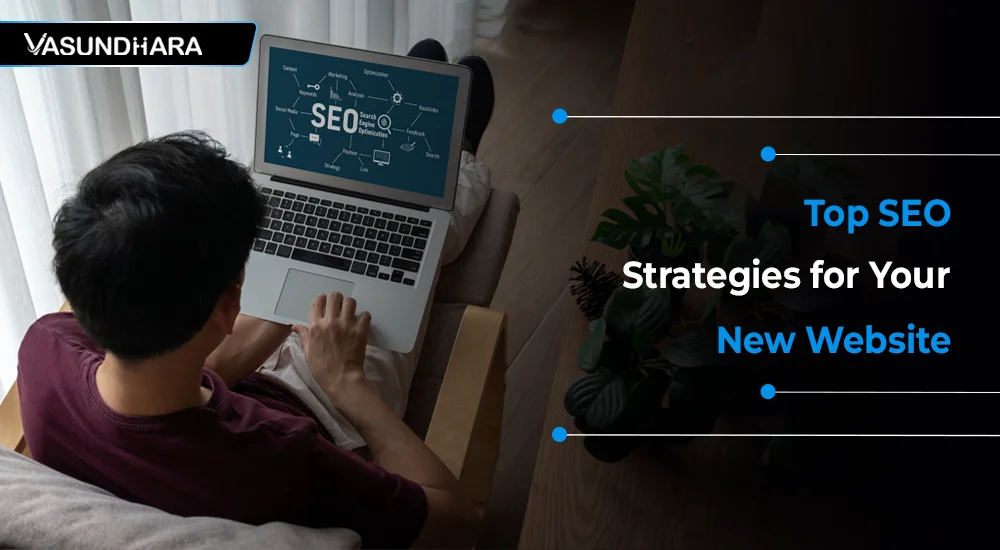Top SEO Strategies For Your New Website
 Chirag Pipaliya
Chirag PipaliyaNov 29, 2024

Search Engine Optimization (SEO) is crucial for the success of any new website. It helps improve your site's visibility, increases traffic, and attracts potential customers by making your site easily discoverable by search engines like Google, Bing, and Yahoo. If you're launching a new website, implementing the right SEO strategies can ensure sustainable growth and help you rank higher in search engine results pages (SERPs).
This guide will cover the top SEO strategies to optimize your new website and improve its performance.
What is SEO?
Search Engine Optimization (SEO) enhances a website’s visibility on search engines like Google, Bing, and Yahoo. By optimizing various elements such as content, keywords, and technical factors, SEO helps websites rank higher in search results for relevant queries.
This increases organic (non-paid) traffic, improves user experience, and boosts a site's credibility. SEO involves both on-page practices like keyword placement and content quality and off-page techniques like building backlinks. The ultimate goal of SEO is to attract more visitors, improve search rankings, and drive business growth.
- Search engines are the starting point for 68% of internet experiences.
- Google accounts for 63.41% of all US online traffic referrals.
- 92.96% of global traffic comes from Google Search, Google Images, and Google Maps. SEO drives 1,000%+ more traffic than organic social media.
- 60% of marketers say that inbound (SEO, blog content, etc.) is their highest quality source of leads.
Also read: How Does A Good Website Add Value To Your Business?
Why Does SEO Matter?
SEO matters because it directly influences a website's visibility and ranking on search engines, which is crucial for attracting organic traffic. In today’s digital landscape, most consumers begin searching for products or services online, and most don't look beyond the first page of search results. Effective SEO ensures that your website ranks higher, increasing the chances of being found by your target audience.
- Increased visibility: Higher rankings mean more visibility.
- Cost-effective marketing: SEO is an organic strategy, meaning you don't need to pay for ads to get traffic.
- Credibility and trust: Websites that rank high are perceived as more credible.
- Better user experience: Good SEO practices improve the usability and experience of your site.
- Long-term results: Unlike paid ads, which disappear when you stop paying, SEO provides long-lasting results.
Beyond visibility, SEO enhances user experience by optimizing site speed, mobile responsiveness, and content quality, leading to higher engagement and conversions. Furthermore, SEO builds credibility and trust, as users tend to trust websites with higher search rankings. It also provides long-term results compared to paid ads, offering a cost-effective way to drive traffic over time.
In short, SEO is essential for improving website visibility, driving traffic, building trust, and fostering long-term business success in an increasingly competitive online environment.
Also read: Why Your Business Needs An E-Commerce Website In 2024
Top 10 SEO Strategies For Your New Website
When launching a new website, implementing effective SEO (Search Engine Optimization) strategies is essential to ensure your site gets noticed by search engines and reaches your target audience. SEO helps improve your site’s visibility, boosts organic traffic, and establishes your brand's online presence. Without a well-structured SEO plan, even the most beautifully designed website may go unnoticed, as search engines rely on various ranking factors to determine where your site appears in search results.
In this guide, we'll explore the top 10 SEO strategies crucial for any new website. These strategies will help you lay a solid foundation for long-term search engine success, attract more visitors, and improve your site's overall performance.
1. Conduct Thorough Keyword Research
Keyword research is the foundation of a global SEO strategy. It involves identifying the phrases and words your target audience uses when searching for products or services similar to yours. Integrating relevant keywords into your website’s content increases the likelihood of appearing in search results for those terms.
How to Conduct Keyword Research:
- Use Tools Like Google Keyword Planner: This tool helps you find keywords with high search volumes and low competition.
- Focus on Long-Tail Keywords: These are specific, longer phrases that may not have as much competition but bring in more targeted traffic. For example, instead of targeting “shoes,” you might focus on “best running shoes for marathon training.”
- Analyze Competitors: Study your competitors’ websites to see which keywords they rank for. This can provide insights into which terms may work for your own strategy.
Integrating Keywords:
- Title Tags and Meta Descriptions: Incorporate primary keywords into your title tags and meta descriptions. These are the first things users see in SERPs.
- Header Tags (H1, H2, etc.): Use your primary and secondary keywords naturally in headings and subheadings.
- URL Structure: Include keywords in the URLs of your pages for better search engine readability.
2. Optimize On-Page SEO Elements
On-page SEO refers to the elements on your website that you can optimize to help search engines understand your content better. Effective on-page SEO improves user experience, which leads to better engagement and higher rankings.
Key On-Page SEO Tactics:
- Title Tags: Ensure each page has a unique title tag (up to 60 characters) with your main keyword.
- Meta Descriptions: Write compelling meta descriptions (150–160 characters) that include your focus keywords and entice users to click.
- Header Tags: Use hierarchical headings (H1 for main titles, H2 for subheadings) to structure content and make navigating your page easier for users and search engines.
- Internal Linking: Link to other relevant pages within your website to help search engines discover your content and distribute link authority.
- Image Optimization: Optimize images by compressing them to reduce loading times and including alt text that describes the image with keywords.
- Mobile-Friendliness: With Google’s mobile-first indexing, ensure your website is responsive and works seamlessly on all devices, particularly mobile phones.
3. Create High-Quality, Engaging Content
Content is at the core of your B2B SEO strategy. Google rewards websites that provide valuable, relevant, and informative content to users. Regularly updating your site with fresh content can help you stay ahead of your competitors and rank higher in search results.
Tips for Content Creation:
- Write for Your Audience: Focus on creating content that solves the problems of your target audience. Blog posts, tutorials, product guides, and FAQs are all useful content formats.
- Use a Mix of Content Types: Besides written content, consider incorporating videos, infographics, and images, which can improve user engagement.
- Maintain Originality: Avoid duplicating content. Search engines penalize websites that feature duplicate or plagiarized content.
- Optimize Content with Keywords: Naturally, incorporate keywords into your content without stuffing them. The focus should always be on providing value to readers.
SEO Content Strategy:
- Publish Regularly: Maintain a consistent publishing schedule to keep your website fresh and active.
- Evergreen Content: Create content that remains relevant over time, such as how-to guides and industry insights.
- Engaging Headlines: Write attention-grabbing headlines that compel users to click. Your primary keyword should be included naturally in the title.
Also read: Top Website Development Company With 10 Years Of Experience
4. Improve Website Speed
Website speed is a critical ranking factor for SEO. If your site loads quickly, users will stay, leading to higher bounce rates and positively affecting your rankings. Google has clarified that page speed impacts user experience and SEO rankings.
Ways to Boost Website Speed:
- Use a Content Delivery Network (CDN): A CDN distributes your website content across multiple servers worldwide, reducing load times for visitors regardless of their location.
- Optimize Images: Compress images without losing quality, and use formats like WebP that load faster than traditional formats like JPEG or PNG.
- Enable Browser Caching: By enabling caching, you allow returning visitors to load your pages faster by saving website elements in their browser.
- Minimize JavaScript and CSS Files: Reduce the size of your CSS, JavaScript, and HTML files. Tools like Google's PageSpeed Insights can help identify large files that need optimization.
5. Build a Solid Internal Linking Structure
Internal linking is essential for SEO because it helps search engines index your site and understand the hierarchy of your content. Proper internal linking also keeps visitors on your site longer, which can reduce bounce rates and increase engagement.
Internal Linking Best Practices:
- Use Descriptive Anchor Text: When linking internally, use descriptive anchor text that tells users and search engines what the linked page is about.
- Link to High-Value Pages: Focus on linking to important pages to your business, such as service pages, blog posts, or landing pages.
- Balance Internal Links: Avoid over-linking on a single page. Keep the number of internal links reasonable and ensure they add value to the reader.
6. Focus on Technical SEO
Technical SEO involves optimizing your website's backend structure to make it easier for search engines to crawl and index your pages. While some aspects of technical SEO may require the help of a developer, understanding the basics is essential for ensuring that your site is SEO-friendly.
Technical SEO Considerations:
- Crawlability: Ensure that search engine bots can easily crawl your site. This involves creating an XML sitemap and submitting it to Google Search Console.
- Secure Website (HTTPS): Google considers HTTPS as a ranking factor. Make sure your website has an SSL certificate to improve security and SEO.
- Fix Broken Links: Regularly check your website for broken links and fix them. Broken links harm user experience and can negatively impact your SEO rankings.
- Schema Markup: Add schema markup to help search engines understand the content on your pages better and enhance your appearance in search results with rich snippets.
7. Prioritize Mobile Optimization
Mobile SEO has become increasingly important with most web traffic coming from mobile devices. Google’s mobile-first indexing means it predominantly uses the mobile version of a site’s content for indexing and ranking.
Mobile Optimization Tips:
- Responsive Design: Use responsive web design so your site adapts to different screen sizes.
- Touch-Friendly Navigation: Ensure that buttons and links are easy to tap on small screens.
- Fast Loading on Mobile: Compress images and reduce the size of files that might slow down your site on mobile devices.
- Avoid Flash and Pop-ups: Flash is not supported on most mobile devices, and intrusive pop-ups can negatively affect the user experience and lead to lower rankings.
8. Leverage Backlink Building
Backlinks, or inbound links, are links from other websites pointing to your site. They are a major ranking factor for SEO because they signal to search engines that your content is trustworthy and authoritative.
How to Build Quality Backlinks:
- Guest Posting: Write guest posts for reputable websites in your industry. Where appropriate, include links back to your site in your author bio or within the content.
- Create Link-Worthy Content: Valuable, original, and informative content is more likely to attract backlinks from other websites. Case studies, infographics, and expert roundups are great examples.
- Reach Out for Links: If you have valuable content, don’t hesitate to contact websites in your niche and ask them to link back to your site. Focus on building relationships with influencers and industry bloggers.
- Monitor Backlinks: Use tools like Ahrefs or Moz to monitor your backlinks and disavow any toxic or low-quality links that might harm your SEO efforts.
9. Monitor SEO Performance with Analytics Tools
Tracking and analyzing your website's performance is important to measuring the success of your SEO efforts. Using the right tools will help you understand what’s working and what needs improvement.
Best SEO Monitoring Tools:
- Google Analytics: Use Google Analytics to track user behavior, traffic sources, and conversions. This tool gives you a detailed understanding of how visitors are interacting with your site.
- Google Search Console: Monitor your website’s presence in search results with Google Search Console. It provides insights into indexing issues, keyword performance, and backlinks.
- Ahrefs and Moz: These tools offer advanced tracking for keyword rankings, backlink profiles, and competitor analysis. They are excellent for in-depth SEO audits.
10. Stay Up-to-Date with SEO Trends
SEO is constantly evolving, with search engines updating their algorithms frequently. Staying current with the latest trends and algorithm changes is crucial to maintaining your rankings and ensuring that your website stays competitive.
Current SEO Trends to Watch:
- Voice Search: As more people use voice search on mobile devices, optimizing your content for conversational queries and natural language is becoming increasingly important.
- AI and Machine Learning: Search engines are incorporating AI and machine learning into their algorithms, making focusing on user intent more than just keywords more important.
- Core Web Vitals: Google’s emphasis on page experience metrics, such as load time, interactivity, and visual stability, means that optimizing for Core Web Vitals is essential for improving SEO performance.
Also read: What Is Agile website development? Everything You Need to Know
Common SEO Mistakes to Avoid
Avoiding these common SEO mistakes can help ensure your website ranks well:
- Keyword stuffing: Overloading your content with keywords can lead to penalties.
- Duplicate content: Search engines may penalize websites with duplicated content.
- Ignoring mobile optimization: With Google’s mobile-first index, neglecting mobile SEO can hurt your rankings.
- Neglecting user experience: A poor user experience (UX) can lead to higher bounce rates, negatively affecting your rankings.
Not tracking results: Without monitoring your SEO performance, it’s impossible to know what’s working and what isn’t.
Conclusion
Building a successful SEO strategy for your new website requires a blend of effective keyword research, on-page optimization, engaging content creation, technical improvements, and a strong backlink profile. By following these top SEO strategies, you can boost your search engine rankings, attract more visitors, and ultimately grow your online presence. Remember, SEO is a long-term process, and consistency is key. Keep refining your strategy, stay informed of algorithm updates, and monitor your performance regularly to stay ahead of the competition.
If you're ready to take your website to the next level and ensure it’s optimized for success, Vasundhara Infotech can help. Our expert web development team specializes in creating SEO-friendly websites designed to attract traffic, engage users, and generate results. Whether you're starting from scratch or looking to optimize an existing site, we have the skills and experience to build a custom solution tailored to your business needs.
Ready to enhance your website’s performance? Contact us today for professional web development services and let us help you create a site that stands out in search results and drives success.






































